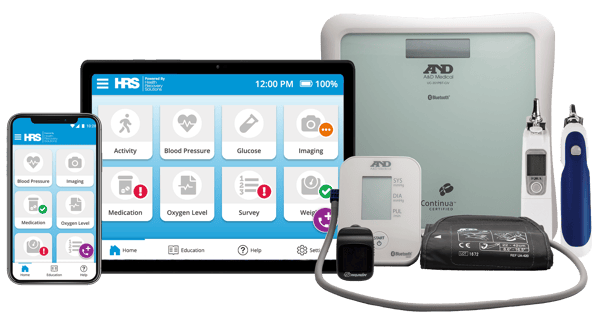We followed up with Marie Menendez, Telehealth Specialist, at Evara Health, after a recent webinar detailing Evara Health’s RPM journey to get the answers to some questions that attendees asked.
Evara Health is a Federally Qualified Health Center (FQHC) located in Pinellas County, Florida, which is a peninsula with just under one million people. It’s the most densely populated county in the state of Florida. As an FQHC, Evara handles a slightly different population than your typical healthcare organization.
Their patient census includes:
- 61% racial or ethnic minorities
- 94% patients below 200% the federal poverty line
- 80% patients below 100% the federal poverty line
- 46% Medicaid or CHIP users
- 25% have no insurance at all
Evara never turns anyone away and will provide access to anyone that needs medical care of any kind that they provide. To better support patients struggling with transportation issues and chronic diseases, Evara sought innovative solutions to improve care delivery. In partnership with HRS, they launched their remote patient monitoring (RPM) program in April 2022.
Today, Evara is expanding their RPM services to cover prenatal and postpartum moms who might have gestational diabetes or other diseases that would benefit from RPM. For a quick overview of Evara and their RPM program, watch this 2.5-minute video clip from the webinar.
Now, let’s break down the questions asked by webinar attendees and the responses:
1. Are there any integrations with existing patient portals or do they have to log into a separate portal? EG: Epic, MyChart
Not yet. We recently migrated from an older EHR over to Epic and we are just kicking off the project to integrate HRS with Epic. That's one of the other reasons we're so happy to be working with HRS, they do have an integration with Epic. Some of the other organizations that are already on HRS have done the integration and it works. We're hoping to be able to utilize some of the benefits that they've provided. One of the things that we are now looking at is that RPM collects a tremendous amount of data. One of the things you need to think about when you're looking at integration is, are you going to have data overload? Is there too much data coming in? So, what kind of integration do you really want? And that's one of the things we're looking at right now. Do we really want every single reading that the patient takes to be brought into Epic? Or do we want just the end of the day? All readings or only readings that are over a certain limit? Do we want to bring them in as discrete data into the patient record? Or are we bringing them in as a PDF into the patient record?
There's a lot of considerations you need to go through when you're looking at integration, and we're looking through all of those right now.
2. How much manual tracking have you had to do vs. being able to report on metrics through your EMR?
We're using a program inside Epic to do some reporting and also reporting out of the HRS ClinicianConnect® portal.3. Is the telehealth platform run through Epic, or is it an external platform?
When we say “telehealth,” we mean explicitly video appointments. We do have a third-party program for that. We do not use HRS's telehealth program. We are not currently integrated with Epic but it is on our to-do list.
4. Do you use all internal teams to monitor these devices?
Yes, from a clinical monitoring perspective, we’ve found that consistency is key. We have the same dedicated nurses, who are monitoring the portal during office hours. They've got a program policies and procedures, they are running first passes of all of the high-risk alerts for non-compliance.
For us non-compliance is any value that's incomplete or any value that's too high, and we do some outreach to address that. We rely mostly on phone calls, and then text messages through the RPM portal, and then our nurses are doing and pass of the moderate risk and then the non-adherent patients. So, they're doing constant, regular outreach to encourage patients to test their vitals. They're getting to know them on a personal level. They recognize when vitals are like, normal for a patient or normal high, that constant and consistent encouragement is where we're seeing the most movement. We're looking for abnormal symptoms. Whether or not patients took their medications for the day, we’re either assisting them with medication management, providing some kind of education or, in those unfortunate cases, where escalation to the providers is needed.

24/7 Clinical Monitoring and Triage Support
Empower your clinical team and patients with round-the-clock clinical monitoring support with HRS CareConnect™
5. You've shared enrollment data, how about engagement? How do you define engagement?
For patient engagement, we're relying on the out-of-the-box reports that are available in the portal, like the adherence reports, just to see if our patients are participating.
6. Did you mention that nurses within your clinics are helping distribute devices to patients as they are enrolled?
Yes, that is correct. We have found that the nurses are in the best position to educate the patients on how to use the devices, if they're not already familiar, and to encourage them to participate daily, to encourage appropriate times. So yes, our nurses, our center RN team leads are doing that.7. How has success been in rural areas?
Pinellas County actually is the most densely populated county in the state of Florida, so unfortunately we don't have a lot of experience in terms of the rural area. Although many of our patients live in areas that may be “deserts” in terms of WiFi coverage or cell coverage, which does make it difficult sometimes.
HRS has been great working with us. If, for example, we have a patient who may not have AT&T coverage in their area, HRS can put a sim chip for Verizon in the tablet for us, so that we can provide services to that patient. There is a lot of flexibility in terms of that, but one of the benefits is using the cellular technology, which is generally ubiquitous, at least in this county.
8. What is an RPM kit?
HRS sends out a remote patient monitoring kit that includes a couple peripheral devices which can be customized for the patient. It includes a tablet and usually a blood pressure monitor device, a scale, a pulse ox device. You can include a thermometer if needed. Those components are what make up the kits and they can be customized to be condition-specific.
 A PatientConnect® remote patient monitoring kit featuring a tablet, mobile app, scale, blood pressure cuff, thermometer, and glucometer.
A PatientConnect® remote patient monitoring kit featuring a tablet, mobile app, scale, blood pressure cuff, thermometer, and glucometer.
9. What is your breakdown of tablet, app & IVR use?
For family medicine patients, about 80% of them, who tend to be older, mostly rely mostly on the RPM kit with the tablet. The women's health team is almost exclusively mobile. I would say, 75% to 80% of them use the mobile app, 25% use the RPM kit, and family medicine is the opposite. We're not doing any IVR, we're only using the kits and the mobile app. We don't have any patients manually submitting their results.
10. I’m an advanced practice nurse running the RPM program for gestational diabetes mellitus (GDM) and hypertension. The patients are all on mobile devices and language barrier is a very big problem in my underserved population. What is the language capability of your RPM program?
HRS has many language settings (16 languages) within the PatientConnect app that do break that barrier. If there's a language barrier concern while we're doing the setup, we have a third party that we use for translation services like we can call them up on the phone or we can like visit a specific website if we need, like a visual for ASL.
But within the app itself, the settings are there and available. This is one of the things that tipped us into choosing HRS. It wasn’t the only thing, but it was one of many things. It was a big factor for us.
_Community%20Health%20Centers%20(1071%20x%20800%20px).jpg)
See How HRS Helps Community Health Centers (CHCs, RHCs, FQHCs)
HRS partners with FQHCs like Evara Health to improve patient outcomes and expand access to care for underserved populations with RPM.